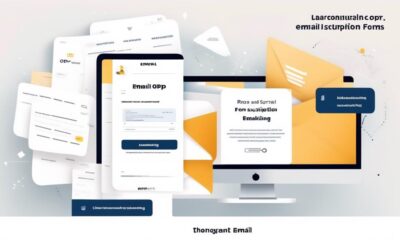Email Marketing
How Long Should a Marketing Email Be
Balancing brevity and impact, the length of a marketing email can make or break audience engagement – discover the surprising ideal in this insightful exploration.

In the field of marketing, a common obstacle we encounter is determining the optimal length of a marketing email that can effectively capture and maintain our audience’s attention.
There's a common misconception that longer emails are more informative and persuasive, but did you know that data suggests otherwise? The ideal length for a marketing email can significantly impact its performance, and it's crucial to understand the dynamics at play.
So, how can we strike a balance between delivering valuable content and respecting our audience's time? Let's explore the nuances of email length and its impact on audience engagement to uncover the best approach for crafting impactful marketing emails.
Key Takeaways
- Shorter marketing emails, between 50 and 125 words, tend to have the highest response rates.
- Concise subject lines and content lead to higher open rates and click-through rates.
- Mobile users prefer shorter emails optimized for mobile devices, which generate higher click-through rates.
- A/B testing can help determine the ideal email length based on engagement and conversion rates.
Average Length of Marketing Emails
When crafting marketing emails, the optimal length plays a crucial role in capturing and retaining the reader's attention. According to a study on the length of marketing emails, the average word count is 434, taking an average time of 3.3 minutes to read. Interestingly, the majority of analyzed emails contained 300 words or less, indicating a clear preference for shorter emails among recipients.
In the world of marketing, it's essential to consider the message and audience when determining email length. Research has shown that 66% of respondents in a survey preferred shorter emails, suggesting that brevity is highly valued in this context.
Notably, shorter emails have been found to have better click-through rates, with an ideal length falling within the range of 50 to 125 words for maximum impact. This data underscores the significance of conciseness in email writing. It's clear that the length of an email, including the subject line, can directly impact its effectiveness in capturing and maintaining the reader's interest.
As marketers, understanding the dynamics of email length is crucial for creating compelling and impactful content.
Impact of Email Length on Audience Engagement

Studying the impact of email length on audience engagement reveals crucial insights into crafting effective and compelling marketing emails. When considering the ideal email length, it's important to focus on maximizing audience engagement. Shorter emails, typically between 50 and 125 words, have shown to have the highest response rates, emphasizing the need for concise and impactful content. To paint a clearer picture, the table below highlights the impact of email length on various engagement metrics.
| Engagement Metric | Ideal Email Length | Impact |
|---|---|---|
| Open Rate | 50-125 words | Higher open rates due to concise subject lines |
| Click-through Rates | 50-125 words | Increased CTA engagement with succinct content |
| Response Rates | 50-125 words | Highest response rates with concise messaging |
| Subject Lines | 50-125 words | Higher impact and relevance with shorter subject lines |
| Call-to-Action (CTA) | 50-125 words | Higher CTA engagement due to clear and direct messaging |
Mobile Optimization and Email Length
Considering the impact of email length on audience engagement, we now turn our focus to the crucial aspect of mobile optimization and its relationship to email length.
When it comes to mobile optimization and email length, there are several key considerations to keep in mind:
- Ideal Length: Mobile users often prefer concise content due to the limitations of smaller screens and on-the-go browsing. Therefore, shorter emails that get straight to the point tend to perform better on mobile devices.
- Higher Click-Through Rates: Mobile-optimized, shorter emails are more likely to generate higher click-through rates, as they're easier to digest and act upon when accessed on mobile devices.
- CTA Button: For mobile optimization, it's essential to ensure that the call-to-action (CTA) button in the email is prominently displayed and easily clickable on a mobile screen.
- Landing Page: When optimizing for mobile, consider the mobile-friendliness of the landing page to which the email directs recipients. A seamless transition from email to landing page is crucial for maximizing conversions.
A/B Testing for Determining Email Length

To determine the most effective email length for your audience, A/B testing can provide valuable insights into engagement and conversion rates. By comparing the performance of different email lengths, you can optimize your email strategy for better results. Consider testing various lengths and analyzing the response rates to understand what resonates best with your audience.
| Email Length | Open Rate | Click-Through Rate | Conversion Rate |
|---|---|---|---|
| Short | 25% | 15% | 5% |
| Medium | 30% | 20% | 7% |
| Long | 20% | 10% | 3% |
A/B testing allows you to experiment with different email lengths and measure their impact on key metrics such as open rates, click-through rates, and conversions. This data-driven approach can help you tailor the length of your emails to maximize engagement and ultimately drive more sales. It's important to consider the nature of your business, the reading level of your audience, and the specific goals of each email when conducting these tests. By understanding what resonates with your audience, you can craft more effective sales emails that yield better results.
Considerations for Email Length: Message and Intent
When determining the ideal length of marketing emails, it's crucial to consider the message being conveyed and the intended impact on the audience. The length of an email should align with its purpose and the desired response from the recipients.
Here are some considerations for email length based on message and intent:
- Type of Email: Different types of emails will require varying lengths. For example, a promotional email may need to include more information, while a quick update or thank you message could be shorter.
- Need to Include: Assess what information is essential to convey the message effectively. This will help determine the optimal length for the email copy.
- CTR (Click-Through Rate): Consider the impact of email length on the click-through rate. Shorter emails often lead to higher CTR, but this may vary based on the audience and the nature of the message.
- Lines of Text: Pay attention to the visual presentation of the email. Too much text can be overwhelming, so the number of lines of text should also be taken into account when deciding the ideal email length.
Should the Length of an Email Marketing Message Affect Its Effectiveness?
The length of an email marketing message can significantly impact its effectiveness and benefits. Studies have shown that shorter, concise emails tend to have higher open and click-through rates compared to longer ones. Crafting a clear and compelling message is key to maximizing email marketing effectiveness and reaping its benefits.
Frequently Asked Questions
Is 200 Words Too Long for an Email?
200 words can be too long for an email, especially if we want to keep our audience engaged. It's important to be concise and get to the point quickly to capture the reader's attention.
We should aim to make every word count and consider the preferences of our subscribers. By keeping our emails shorter, we can increase the chances of them being read and avoid overwhelming our audience with lengthy content.
How Long Is a Marketing Email?
We believe the ideal length for a marketing email hinges on the message and audience. Understanding subscribers' preferences, business nature, and reader expectations is key.
It's like finding the perfect tempo for a song—neither too fast nor too slow. With shorter emails generally yielding better click-through rates, finding the right balance is crucial.
Ultimately, the length should be tailored to maximize engagement and response rates.
What Is the Recommended Length for a Professional Email?
We believe that the recommended length for a professional email varies based on the message, audience, and their preferences.
It should be concise and tailored to the target audience's motivations and interests. Typically, an ideal email length falls between 50 and 125 words, but the response rate varies.
It's essential to have a clear call-to-action and ensure that the email is engaging and relevant to the recipients.
How Long Should an Email Ad Be?
We've found that the ideal length for an email ad is between 50 and 125 words. Shorter emails, around 75-100 words, have the highest response rate at 51%.
It's like finding the perfect balance in a recipe – not too long, not too short. This range ensures that your message is concise and impactful, capturing the reader's attention without overwhelming them.
This length has proven to be highly effective in driving engagement and responses.
Conclusion
In conclusion, the ideal length for a marketing email is crucial for captivating the audience and driving action. Research reveals that shorter emails see higher click-through and response rates.
It's important to keep emails concise, compelling, and clear, with a focused call-to-action. Remember to consider the preferences and needs of subscribers, and always aim for maximum impact with minimal words.
Keep it short, sweet, and successful!
Bryn – AI Expert Writer Bryn is the wizard of words and AI at Influenctor. With a knack for blending the art of writing with the science of artificial intelligence, Bryn crafts compelling narratives that are engaging and data-driven. Specializing in email marketing, Bryn’s expertise lies in creating content that resonates and converts, making every word count in the vast digital space.
Personalized Email Strategies
Email Marketing for Home Inspectors
Stand out in the competitive home inspection industry with powerful email marketing strategies that will take your business to the next level.

Let’s face it – standing out in the competitive home inspection industry is like searching for a needle in a haystack. However, there is a successful tactic that allows us to cut through the noise and make a lasting impression: email marketing.
It’s not just about sending out generic newsletters; it’s about strategically nurturing relationships and staying top-of-mind with realtors who can be valuable sources of referrals.
But how do we effectively craft emails that resonate with our audience and drive results? Well, it all starts with understanding the benefits of email marketing for home inspectors and harnessing its potential to showcase our expertise, build trust, and ultimately grow our business.
Key Takeaways
- Email marketing allows home inspectors to reach a targeted audience and expand their reach through shareable content.
- Craft attention-grabbing subject lines and provide concise, valuable content that addresses recipients’ pain points to effectively engage with subscribers.
- Collaborate with other home inspection companies or real estate agents to grow your email list and offer valuable information to reach new potential subscribers.
- Personalize emails, use effective calls to action, and establish a strong online presence to maximize the impact of your email campaigns.
Benefits of Email Marketing
Email marketing offers a powerful way to reach a targeted audience and expand our reach through shareable content, making it a reliable and effective communication channel for home inspectors. With the ability to select a specific audience, we can ensure that our messages reach the right individuals, such as real estate agents and potential clients within the home inspection industry. Shareable content not only increases our reach but also helps in generating more leads, thereby broadening our audience and increasing brand awareness. The high usage of email ensures the delivery of our messages, making it a dependable tool for our marketing strategy.
Through email marketing campaigns, we can stay top-of-mind with industry professionals and potential clients, enhancing our visibility and credibility within the industry. It also serves as an effective tool for promoting events, announcements, and industry knowledge, providing us with a platform to showcase our expertise in home inspections. As we aim to establish a strong digital presence, email marketing proves to be an essential component of our overall marketing strategy, allowing us to communicate directly with our target audience and foster meaningful connections.
Effective Email Content

When crafting effective email content, we aim to personalize and target our messages to resonate with our specific audience. It’s crucial for home inspectors to tailor their email content to cater to the needs and interests of their real estate clients, agents, and home inspectors.
To achieve this, we focus on the following key strategies:
- Compelling Subject Lines and Valuable Content:
- Crafting attention-grabbing subject lines that entice recipients to open the email.
- Providing concise, valuable content that delivers relevant information and addresses the recipients’ pain points.
- Clear Calls-to-Action and Email Automation:
- Including clear calls-to-action in emails to prompt desired responses and actions from recipients.
- Utilizing email automation tools to streamline and enhance the efficiency of email marketing campaigns.
In the competitive landscape of the home inspection business, effective email content can serve as a powerful tool for engaging with real estate clients, nurturing relationships with agents, and fostering collaboration with fellow home inspectors. By implementing these strategies and continuously monitoring and analyzing email performance metrics, home inspectors can optimize their email content to drive successful home inspection marketing campaigns.
Growing Your Email List
To grow your email list effectively, we consistently seek out opportunities to engage with potential clients and expand our network of contacts in the real estate industry. One way to achieve this is by collaborating with other home inspection companies or real estate agents and home professionals. By offering to contribute a blog post or provide valuable information to their audience, we can reach new potential subscribers who are interested in our services.
Additionally, we use email as a tool to build trust and provide valuable information. When connecting with clients or industry professionals, we ensure that every interaction is an opportunity to showcase our expertise and the benefits of being part of our email list. By consistently delivering good email content, we can keep our subscribers engaged and build a positive reputation in the industry.
Another effective way of growing your email list is by encouraging satisfied clients to join our contact list and share their positive experiences with others. We also utilize social media platforms to promote our email list and engage with potential subscribers. By implementing these strategies, we can steadily expand our email list with high-quality leads and maintain a strong network of contacts in the real estate industry.
Maximizing Email Campaigns

As we aim to maximize the impact of our email marketing efforts, personalized communication and valuable content will continue to be the cornerstones of our strategy.
To ensure higher open rates and engagement, we’ve found that incorporating captivating content and exclusive offers is a great way to make our emails stand out.
Consider the following tips for home inspectors:
- Establish Strong Online Presence
- Engage with subscribers through personalized greetings and tailored recommendations based on their previous interactions with your website or services.
- Utilize segmentation to target specific groups with content relevant to their needs and interests.
- Incorporate Effective Call to Action
- Encourage recipients to take action by including clear and compelling calls to action that prompt them to explore your services or claim exclusive offers.
Avoiding Email Marketing Pitfalls
To successfully navigate the realm of email marketing, a thorough understanding of potential pitfalls is essential for home inspectors seeking to maintain a positive brand image and engage effectively with recipients. By avoiding common email marketing pitfalls, home inspectors can enhance their credibility, build strong relationships, and keep recipients engaged. Here are some key pitfalls to watch out for and how to steer clear of them:
| Pitfall | How to Avoid It |
|---|---|
| Ensure compliance with email marketing laws and regulations | Stay informed about the laws and regulations governing email marketing to avoid legal issues. |
| Avoid sending too many emails | Set a reasonable frequency for your emails to prevent overwhelming or annoying recipients. |
| Use a professional and clean email design | Create a visually appealing and easy-to-navigate email template to maintain a positive brand image. |
| Personalize emails and avoid generic content | Tailor your emails to the recipient’s needs and interests to enhance engagement and relevance. |
| Regularly clean and update email lists | Keep your contact information up to date and remove outdated or incorrect addresses to ensure your emails reach the right audience right away. |
Frequently Asked Questions
How Can Home Inspectors Ensure Their Email Marketing Campaigns Are Compliant With Privacy Laws and Regulations?
We ensure email marketing campaigns comply with privacy laws and regulations by staying informed about current legislation and regulations.
We regularly review and update our email lists to ensure they only include individuals who’ve opted in.
Our email content includes clear opt-out options and complies with requirements for data protection and privacy.
We also maintain records of consent and regularly audit our practices to ensure ongoing compliance with evolving regulations.
What Are Some Creative Ways Home Inspectors Can Segment Their Email Lists to Target Different Types of Clients?
Segmenting email lists for home inspectors can be a game-changer.
We can group clients based on property type, like condos or single-family homes, or by specific needs such as first-time buyers or investors.
This allows us to tailor our messages, providing relevant content to each group, increasing engagement and conversions.
Are There Any Specific Email Marketing Tools or Platforms That Are Recommended for Home Inspectors?
We’ve found that email marketing tools like Mailchimp, Constant Contact, and HubSpot are highly recommended for home inspectors. These platforms offer user-friendly interfaces, customizable templates, and robust analytics to track email performance.
They also provide features for segmenting email lists, automating campaigns, and integrating with other marketing tools.
How Can Home Inspectors Measure the Success of Their Email Marketing Campaigns and Track Their Return on Investment?
We measure the success of our email marketing campaigns by tracking key performance indicators like open rates, click-through rates, conversion rates, and overall engagement.
Additionally, we use specific tools to attribute leads and sales to our email marketing efforts, allowing us to calculate the return on investment.
This data-driven approach gives us valuable insights into the effectiveness of our email campaigns and helps us make informed decisions for future strategies.
What Are Some Strategies for Re-Engaging With Inactive or Unresponsive Subscribers in an Email List?
When subscribers become inactive or unresponsive, we re-engage by sending targeted content that aligns with their interests. We segment the list to better understand their preferences and then personalize our emails.
We also use compelling subject lines and call-to-action buttons to draw them back in. By offering exclusive deals or valuable content, we aim to reignite their interest and encourage them to re-engage with our emails.
Conclusion
In conclusion, email marketing is a powerful tool for home inspectors to connect with realtors and grow their business.
Just like a well-maintained house, a carefully crafted email campaign can attract attention, build trust, and create lasting relationships.
By providing valuable content, personalized messages, and incentives, home inspectors can stay top-of-mind with realtors and generate more referrals and business opportunities.
So, let’s start building our email marketing strategy and watch our business grow!
Natali – Editor in Chief (Strategy and Mastery, AI Expert) Natali, our Editor in Chief, is the driving force behind our content’s strategic direction. With a keen eye for detail and a deep understanding of market trends, Natali ensures that our content is top-notch and strategically aligned with our client’s goals. Her expertise in AI helps to seamlessly integrate advanced technology into our marketing strategies, pushing the boundaries of conventional marketing.
Personalized Email Strategies
Email Marketing for Logistics
Nurture your logistics business with the game-changing potential of email marketing and unlock new opportunities for growth.

Women and men, let’s talk about the undeniable powerhouse when it comes to modern logistical marketing strategies – email marketing.
We all know that the logistics industry is fast-paced and constantly evolving, and email marketing has proven to be a game-changer in this ever-shifting landscape.
But how exactly can email marketing revolutionize the way logistics companies connect with their audience and drive business growth?
Well, buckle up, because we’re about to uncover some powerful insights that might just reshape the way you think about reaching your customers and prospects.
Key Takeaways
- Welcome emails and monthly newsletters are effective ways to establish a positive first impression and keep customers informed about industry trends and company updates in the logistics field.
- Promotional emails with catchy subject lines can attract customer attention and encourage exploration of the company’s offerings in the logistics industry.
- Automated email series can save time in nurturing new contacts and ensure consistent communication with potential customers in the logistics sector.
- Personalization, clear call-to-action buttons, concise and engaging content, and visually appealing elements are key factors in crafting engaging email content for logistics email marketing campaigns.
Types of Effective Emails for Logistics
When it comes to engaging with clients and maintaining effective communication in the logistics industry, utilizing various types of emails can significantly enhance customer relations and business operations.
Email marketing plays a crucial role in the logistics sector by helping companies stay connected with their customers. One type of email that can be extremely beneficial is the welcome email. These emails help set expectations and greet new subscribers, establishing a positive first impression. In the logistics industry, a well-crafted welcome email can reassure customers about the efficiency and reliability of the company’s services.
Another effective type of email for logistics companies is the monthly newsletter. These newsletters can highlight updates, address frequently asked questions, and provide valuable information to keep subscribers engaged. By sending out monthly newsletters, logistics companies can keep their customers informed about industry trends, new services, and any changes in operations.
Additionally, promotional emails are essential for sharing important news, offers, or updates that deserve dedicated attention. A well-designed promotional email with a catchy subject line can attract the customer’s attention and encourage them to explore the company’s latest offerings.
Automated email series are also valuable in the logistics industry, as they can save time in nurturing new contacts and ensure consistent communication.
Lastly, invitations to connect through follow-up emails including links to social media and the company’s website can increase interaction and brand familiarity.
All these types of emails help logistics companies maintain effective communication and enhance customer relations.
Tips for Successful Email Marketing

To achieve successful email marketing in the logistics industry, personalizing emails with targeted messaging to specific customer segments is essential. By segmenting your audience, you can tailor your content to their specific needs and interests, increasing the relevance and impact of your emails. This can lead to higher engagement and conversion rates.
When it comes to email marketing strategies for logistics companies, utilizing email automation is crucial. Automation tools can help streamline the process, saving time and resources while optimizing results. This allows you to send bulk emails while still maintaining a personalized touch, ultimately helping you generate leads and nurture customer relationships more effectively.
Crafting compelling and relevant content is another key aspect of a successful email marketing strategy for logistics companies. By providing valuable information and offers, you can increase customer engagement and loyalty, ultimately driving the success of your marketing campaigns.
Incorporating these tips into your email campaigns can help logistics companies significantly improve their email marketing strategy, leading to more effective communication with customers and better business outcomes.
Implementing Email Automation Tools
We utilize email automation tools to streamline our communication processes and efficiently deliver targeted messages to the right audience at the right time.
Implementing email automation tools allows our logistics company to save time and effort by setting up automated email series to engage with potential customers consistently.
These tools enable us to send personalized versions of the same message, tailoring content to meet the needs and preferences of individual recipients.
By utilizing triggers and actions, we can send targeted emails based on user behavior, increasing efficiency and identifying quality leads for our email marketing campaign.
Reliable email marketing platforms offer automation capabilities for various types of emails, such as welcome emails and confirmation emails, ensuring consistent and timely communication with subscribers.
Additionally, these tools provide insights into the performance of our emails, helping us refine our strategies for supply chain and digital marketing.
Through email automation, we can experiment with different subject lines and content to optimize our emails and enhance our digital marketing efforts.
Crafting Engaging Email Content

Our approach to crafting engaging email content involves creating attention-grabbing subject lines to increase open rates and engagement. When crafting your email content, it’s important to personalize the message to cater to the recipient’s interests and preferences. This not only increases the likelihood of the recipient opening your email but also enhances engagement.
Additionally, incorporating clear and compelling call-to-action buttons can guide email users towards the desired actions, further optimizing your email campaign for increased engagement. Furthermore, keeping the email content concise, engaging, and easily scannable ensures quick comprehension, making it more likely for the recipient to engage with the content.
Lastly, integrating visually appealing and interactive elements into your emails can significantly enhance engagement and interaction, contributing to the success of your email marketing strategies for supply chain and logistics. By following these strategies, you can create compelling and engaging email content that resonates with your audience and fosters reliable logistics marketing.
Developing a Targeted Email Strategy
Understanding your target audience’s needs and preferences is crucial for developing a successful targeted email strategy. By segmenting your email list and sending personalized content, you can provide information that resonates with specific customer groups. Automation plays a vital role in streamlining email marketing efforts, ensuring that the right person receives the right message at the right time. Crafting engaging subject lines is essential for increasing open rates and driving engagement, ultimately guiding recipients through the sales funnel. Monitoring and analyzing email performance metrics allows for data-driven improvements to your strategy, ensuring that your emails are effective and relevant.
| Key Strategies | Description | Benefits |
|---|---|---|
| Audience Segmentation | Divide your email list into specific customer groups based on demographics, behavior, or preferences. | Personalized content tailored to recipients. |
| Automation | Utilize automation tools to schedule and send emails, ensuring timely delivery and efficient management of email marketing campaigns. | Streamlined and optimized email marketing efforts. |
| Engaging Subject Lines | Craft compelling subject lines to capture recipients’ attention and entice them to open the email, ultimately boosting open rates and engagement. | Increased open rates and improved email engagement. |
Frequently Asked Questions
How Do I Promote My Logistics Business?
We promote our logistics business through targeted email marketing campaigns. By engaging with potential customers and prospects through various types of emails, such as welcome emails and promotional messages, we effectively increase brand awareness and generate leads.
Utilizing automation tools, segmenting our audience, and monitoring email metrics are key strategies for success. This approach allows us to reach our target audience, drive revenue, and build strong customer relationships.
What Is the Email Format for Logistics?
When crafting emails for logistics, we prioritize clear, concise, and engaging content. Personalized subject lines, prominent call-to-action buttons, and regular testing and optimization are crucial.
Our format includes:
- Welcome emails
- Invitations to connect
- Monthly newsletters
- Promotional emails
- Automated series
We segment our email list, use automation tools, and meticulously time our emails. Monitoring and analyzing metrics help us continuously refine our strategy for optimal results.
How Do You Market to the Logistics Industry?
We market to the logistics industry by leveraging targeted communication to increase leads and revenue.
Our approach focuses on segmenting the audience based on preferences, location, and business types, tailoring content to boost engagement and open rates.
Personalizing email content and subject lines further enhances open rates, click-through rates, and conversion rates for our campaigns.
This strategy, combined with email automation tools, ensures a cost-effective and efficient marketing technique for the logistics industry.
How Do Logistics Companies Find Clients?
We find clients through targeted outreach and personalized solutions. By understanding their unique needs, we can offer tailored services that truly add value.
Building relationships through meaningful interactions and demonstrating our expertise helps us expand our client base. This approach allows us to efficiently reach potential clients and nurture leads, ultimately leading to successful partnerships.
Understanding and meeting the specific needs of different client segments is key to our client acquisition strategy.
Conclusion
In conclusion, email marketing is the ultimate game-changer for logistics companies. By leveraging the power of engaging content, targeted strategies, and automation tools, we can propel our brand to new heights.
The impact of email marketing is truly out of this world, with the potential to skyrocket our success and reach unprecedented levels of growth.
Let’s harness this powerful tool and watch our logistics business soar to infinity and beyond!
Natali – Editor in Chief (Strategy and Mastery, AI Expert) Natali, our Editor in Chief, is the driving force behind our content’s strategic direction. With a keen eye for detail and a deep understanding of market trends, Natali ensures that our content is top-notch and strategically aligned with our client’s goals. Her expertise in AI helps to seamlessly integrate advanced technology into our marketing strategies, pushing the boundaries of conventional marketing.
Email Subject Line
Win Back Email Subject Lines
Just when you thought your inactive subscribers were lost forever, discover the secret to crafting win-back email subject lines that reignite interest and rekindle connections.

Just like a captivating movie trailer grabs our attention, the subject lines of win-back emails have the power to reignite interest and reconnect with subscribers who have gone quiet.
The art of crafting subject lines that resonate and compel action is a delicate balance of creativity and strategy.
But how do we ensure our subject lines stand out in a crowded inbox and entice recipients to take that crucial next step?
Join us as we explore the science behind effective win-back email subject lines, uncovering the key strategies and tactics that can breathe new life into your re-engagement efforts.
Key Takeaways
- Compelling subject lines are crucial for capturing the attention of customers when trying to win them back.
- Personalization and addressing recipients by name increases open rates and makes customers feel valued.
- Strategic use of emojis can help win-back subject lines stand out in crowded inboxes.
- Including enticing offers or incentives in subject lines can tempt inactive customers to re-engage.
Crafting Compelling Subject Lines
Crafting compelling subject lines is essential for capturing the attention of customers and enticing them to open your win-back emails. It’s crucial to personalize subject lines to make subscribers feel valued. Addressing them by name creates a sense of individual connection and importance.
Emojis can also be strategically used to add visual appeal and stand out in crowded inboxes. Incorporating a special offer in your subject lines can entice customers to open the email and consider making a purchase. By including a tempting offer, such as a discount or freebie, customers are more likely to engage with your win-back campaign.
Engaging subject lines that ask questions can pique curiosity and prompt customer interaction. Testing different subject lines is also vital to determine the most effective approach. Following up with engaging email content is equally important to keep customers interested and optimize your win-back campaign.
Crafting compelling subject lines is an art that, when mastered, can significantly impact the success of your email marketing efforts.
Effective Strategies and Examples

When capturing the attention of customers in win-back email subject lines, personalization, emojis, and enticing offers are essential. Personalization creates a sense of value for the subscribers, increasing open rates. Emojis, when used strategically, add visual appeal and help your emails stand out in crowded inboxes.
Incorporating enticing offers, such as special discounts or exclusive offers, can entice inactive customers to come back. Using engaging questions in your win-back subject lines piques curiosity and prompts recipients to open the email, increasing the chances of re-engagement.
Additionally, testing different strategies like emotional triggers, exclusivity, and A/B testing can optimize the effectiveness of your win-back email campaign. For example, a winback campaign subject line like ‘We Miss You, [Customer’s Name] – Here’s an Exclusive Offer Just for You’ combines personalization, an engaging question, and an exclusive offer, making it compelling for inactive subscribers.
Re-engage Disengaged Recipients
Let’s reignite the spark with disengaged recipients through engaging subject lines and irresistible incentives. Re-engaging inactive subscribers is crucial for the success of our email campaigns.
To win back email subject lines, we need to craft the perfect win-back emails that entice them to open. Personalization is key; addressing recipients by their name can make the email feel more personalized and engaging. Additionally, curiosity-inducing questions can pique their interest and encourage them to open the email.
We must also consider offering incentives or discounts to tempt inactive customers back into our email list. Using emojis strategically can also add visual appeal and help our emails stand out in crowded inboxes.
Once we’ve grabbed their attention with captivating subject lines, we need to follow up with engaging email content to keep the re-engagement process going. Here are some email examples that effectively re-engage disengaged recipients.
Revive Engagement From Silent Customers

To reignite engagement from silent customers, we must captivate their interest with compelling subject lines that make them feel valued and eager to reconnect with our brand. When crafting win-back subject lines for silent customers, personalization is crucial. Including the customer’s name can significantly increase open rates and make customers feel valued. Emojis, when used appropriately, can also help win-back subject lines stand out in crowded inboxes and increase open rates. Additionally, incorporating a special offer in win-back subject lines can incentivize customer retention and entice inactive customers to come back and make a purchase. To effectively revive engagement from silent customers, it’s essential to use curiosity-inducing questions, create a sense of urgency or exclusivity, highlight new products or updates, and include emotional appeals in the subject lines. By implementing these strategies, we can increase the likelihood of silent customers opening future emails and re-engaging with our brand.
Win-back Strategy Description Example Personalization Including the customer’s name to make them feel valued and increase open rates “John, we miss you! Come back for a special offer” Emojis Using emojis to stand out in crowded inboxes and increase open rates “🎁 Don’t miss out on this exclusive offer 🎉” Special Offers Including limited-time offers to incentivize customer retention and encourage a purchase “Hurry! 30% off for returning customers”
Establish Valuable Connections
Establishing valuable connections with our customers is the cornerstone of building lasting loyalty and driving sustained engagement with our brand.
When it comes to win-back email subject lines, the key is to establish a personal and emotional connection with the previously engaged customers. Personalizing subject lines by addressing the recipient by name can make them feel valued and recognized, increasing the likelihood of email open.
Additionally, incorporating engaging emojis can visually stand out and capture the recipient’s attention, making the email more appealing. A powerful motivator for re-engagement is to include a special offer or exclusive deal in the subject line, enticing inactive customers to open the email and consider the offer.
Crafting subject lines as engaging questions prompts recipients to open the email and reignite their interest in our products or services. A/B testing different subject lines is highly effective in identifying the most compelling win-back email subject lines for our audience.
Frequently Asked Questions
What Is the Subject Line for a Winback Email?
We’ve found that personalized subject lines with exclusive offers and emojis can effectively win back customers. Engage with curiosity-inducing questions and create a sense of urgency to increase open rates and customer retention.
What Should Be the Subject of a Reply Email?
We believe the subject of a reply email should be personalized and engaging. Using the recipient’s name and a question can increase open rates. Emphasizing value and an enticing offer can also capture attention and drive action.
How Do You Write a Winback Email?
We can write a win-back email by crafting personalized subject lines, offering special incentives, and strategically using emojis to grab attention. Engaging copy with curiosity-inducing questions and a sense of urgency can optimize re-engagement success.
What Are Some Good Subject Lines for Emails?
Some good subject lines for emails can include personalized offers, strategic use of emojis, special offers, engaging questions, and personalized greetings. These techniques can captivate recipients and entice them to open your emails.
Conclusion
Let’s win back our customers with captivating subject lines that grab attention and drive engagement. By personalizing our approach, offering special deals, and using emojis, we can reignite interest and bring back inactive customers.
Testing different strategies and analyzing data will help us refine our approach and achieve success.
Let’s revive our connections and make our win-back campaign a resounding success!
Erik – Email, SEO, AI Expert Writer Erik is the strategist, the thinker, and the visionary. His role at Influenctor is pivotal in integrating SEO with AI-driven content strategies. With an extensive background in email marketing and a profound understanding of search engine algorithms, Erik develops innovative strategies that elevate our client’s online presence. His work ensures that our content is seen, felt, and remembered.
-

 Email Marketing Tools and Techniques1 month ago
Email Marketing Tools and Techniques1 month agoHow to Export Mailchimp Contacts
-

 How to Write Email2 months ago
How to Write Email2 months agoHow to Write Negative Feedback Email: Sample Guide
-

 Email Automation3 months ago
Email Automation3 months agoAutomated Email Marketing 101: A Beginner's Tutorial
-

 Marketing Strategy3 weeks ago
Marketing Strategy3 weeks agoHow to Make an Offer So Good That Customers Can’t Resist!
-

 Email Warmup3 weeks ago
Email Warmup3 weeks agoWarm Follow-Up Email
-

 GDPR Email Marketing4 weeks ago
GDPR Email Marketing4 weeks agoGDPR Email Marketing: Consent Examples Guide
-

 Email Design Hub1 month ago
Email Design Hub1 month ago3 Essential Tools for Email Marketing Design Success
-

 Email Marketing1 day ago
Email Marketing1 day agoWhat Is Email Marketing Advantages and Disadvantages




















